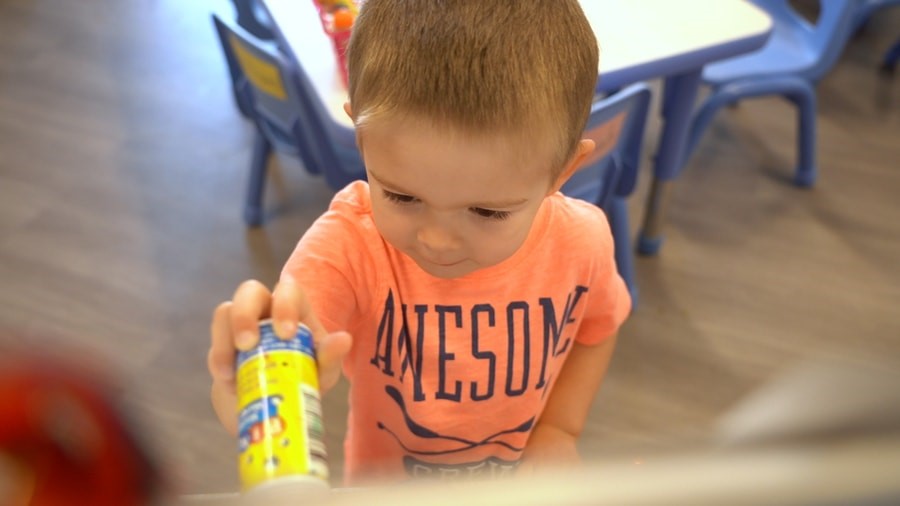- 855.224.8655
- Schedule a Tour

Have you ever gotten artwork from your child’s school and thought it didn’t look like anything? Here’s why that’s okay!
As a parent, you can probably think of a time when your child drew something like a pink dog, and you thought there’s no way a dog can be pink. While it feels like a concern, your child is actually learning a lot by simply creating. And, he or she feels very proud to show you that pink dog.
While it can be easy to focus on the end result, it can hinder a child’s creativity and discourage independence, self-motivation, and other skills. Instead, it’s important to focus on the process of creativity over the end product. This is known in education as process art vs. product art.
Differences Between Product and Process Art
As implied by the name, product art focuses on the end result. Children are provided a model to work from and step-by-step instructions to follow. They are expected to produce an end result that resembles the original example. Parents and teachers who follow a product art approach may correct children’s “mistakes” and focus on the “right” way to do things
A product art approach may have unintended and unwanted side effects, especially in early childhood. Children may not engage with the project if they are not creating something that has personal significance to them. They may become frustrated if their end result is not exactly similar to the model that was provided, and self-esteem may suffer if they feel that they are not living up to expectations.
Process art allows the child to be creative and innovative. It’s all about the process of creation rather than the creation itself. Each art experience is unique to each child and is based on his or her background, interests, etc.
Benefits of Process Art
Perhaps the most apparent benefit of a process approach to art for a child is the development of self-esteem. Because there is no right or wrong way to do things, there is no possibility of failure. Cognitive skills are also enhanced through process art, as children make plans about what to create and apply problem-solving skills in order to manifest what they envision.
The educational benefits of process art are more concrete as well. Working with art materials can help to develop children’s fine motor skills as they paint, draw, or use scissors and glue to make a collage. Additionally, talking about their artwork can help to enhance language skills.
Process vs. Product in the Classroom
Art is an important part of STEAM (science, technology, engineering, art, and math) education. All STEAM projects are designed to be hands-on, where students can apply their imagination and critical thinking skills. STEAM education is an important component of U-GRO Learning Centres’ curriculum, and we create learning opportunities in each domain, including art. Team members utilize the process art approach in our classrooms with toddlers and preschoolers.
With process focused art, teachers introduce new tools to toddlers so they can learn and experiment to create new things. For example, children learn to use a leaf in paint and put it on paper. Teachers may invite children to create something based off of students’ interests. For toddlers, it’s about participating in the creation of something new, which bolsters self-confidence and independence.
Children then build upon what they learned in toddler classrooms, using more creativity and less direction once they are in preschool. Additionally, the things they create are based on developmentally appropriate activities, like 3D art. Process art encourages self-expression, imagination, and self-confidence in preschoolers, all of which are important social-emotional skills that are indicative of kindergarten readiness.
Regardless of age, teachers will provide open-ended, creative art experiences where they can focus on the process of doing.
Process Art at Home
Parents have a minimal role in process art. They should be less of an instructor and more of a guide or facilitator. Provide art materials, encourage children to create whatever they want, and keep the process positive and joyful.
Instead of telling your child what to create, let him or her take the lead. Ask questions and make observations without judgment. It’s just like letting your child play on his or her own. You’ll be amazed at where your child’s imagination can go with art!
Questions to Ask When Children are Creating Art
Here are some open-ended questions parents or teachers can ask children during process art activities. These questions support higher level thinking as children go through the “process” of creating art.
- What made you think of creating your painting/art?
- What does your art remind you of?
- How did you decide to use those colors?
- What else can you do to make _________work?
- What can you tell me about your picture/art?
- How were you feeling when you did this?
- What do you like about your art?
- What do you think we can do with _________ ? (any art supplies that are near the child)
- Can you tell me how you made all those colors?
- What can we do with this when we’re done making it?
It’s okay if the piece of art doesn’t make sense to you. Hang it on the fridge anyway. Your child will feel proud and confident of his or her artwork!
Process art is an important part of encouraging creativity, a skill we build upon with your child in our preschool program. Creativity is one of many skills we focus on to help children be successful in kindergarten and in life.
